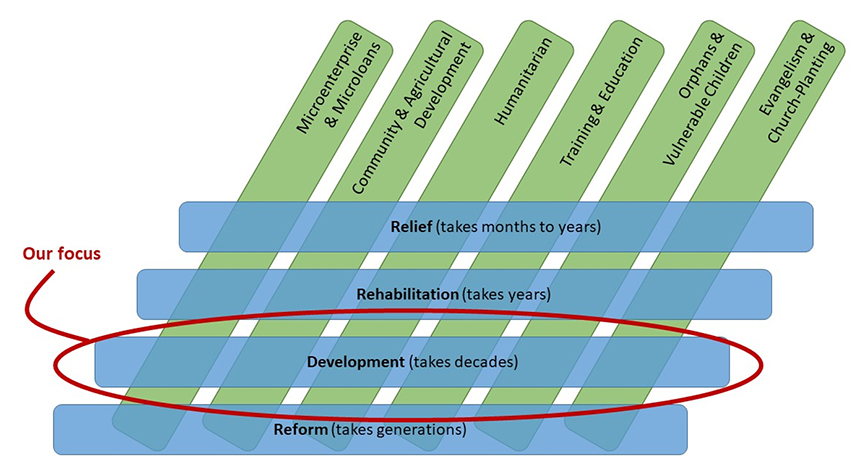
New Zealand-based Bright Hope World is made up of a highly committed group of volunteers driven by a concern for the poorest of the poor, and a desire to see them become physically and spiritually self-sustaining.
In the United States Bright Hope World has a 501c3 registered organizational arm called Bright Hope World USA (BHWUSA).
BHWUSA is adminstered by a group of busienssman who share Bright Hope World's passion for alleviating poverty through visionary indigenous people.
In Canada, Bright Hope World is represented by local organisation Bright Hope for Tomorrow (BHFT).
BHFT is a Christian relief and development ministry committed to helping the absolute poor, those who earn less than a dollar a day. The work of Bright Hope for Tomorrow Mission is overseen by a volunteer board.
In the United Kingdom Shared Hope represents Bright Hope World.
The Christian ethos of Shared Hope is based on what Jesus Christ said was the second great commandment - "You shall love your neighbour as yourself".
Shared Hope and Bright Hope World work together on projects researched by Bright Hope World, by either financing them through Shared Hope, or by securing finance for them and transferring this finance to Bright Hope World.
The key concept behind the work Bright Hope World does is partnership.
Everything we do is within the context of partnership. We find the best of the best; the exceptional people who have a compelling vision to transform their communities. We find the people who are already doing good work among the poorest of the poor, and we help them to develop and grow it over time.
So, in essence, we are not the source of the 'big ideas' but our team works very closely and relationally with our partners to help guide their vision to fruition.
The following video gives a short (and light-hearted) idea of how we do this:
To better understand how we partner with the poor, check out this episode of our podcast 'It Ain't That Simple Mate!':
Our aim is to see lives changed and the poor empowered through six different types of partnership (most of our partnerships cover two or more of these types):
Providing small loans to help initiate small businesses is a key strategy for helping lift communities out of poverty. We have helped formulate approaches that achieve very high payback rates and stronger community outcomes. Critically, microloans give people an opportunity to provide for their own lives and families, avoiding dependency and helping them to fully participate in local economies.
Strong communities are critical in helping the poorest of the poor emerge from poverty. We are connected to partners throughout the developing world that are working to strengthen communities by addressing underlying issues, challenging mind-sets and providing economic opportunities. We are particularly engaged with providing Foundations for Farming training to promote effective agriculture.
Many of our partnerships aim simply to improve the living conditions and quality of life for people in the most marginalised communities. This may be through access to healthcare, social support or relief after a natural disaster or conflict.
We have a strong focus on vocational training, enabling the poorest of the poor to attain the skills they need to secure sustainable employment or start small businesses.
Poverty tends to disproportionately affect children. We work with our partners to ensure that vulnerable children are protected, have access to education and are able to pursue opportunities for the future that will help lift them out of poverty.
The Gospel is at the heart of everything we do. We are not interested in simply solving economic problems, but focus also on addressing the spiritual problems that cause poverty, and keep people locked into cycles of intergenerational poverty.
Beyond these categories of partnerships, there are also four levels of engagement in transforming communities that determine how we get involved, and what the timeframes are likely to be:
Relief is a response to a crisis such as a tsunami or war. It is about meeting short-term unexpected needs. This is a phase that takes months or years.
Rehabilitation typically follows a relief situation. It focuses on returning people to the kind of life they had before the crisis. This tends to take years.
Development is about lifting an entire community out of poverty and addressing the core issues that give rise to poverty. This takes decades.
Reform is about changing the cultural, political and economic systems that allow poverty to perpetuate. This takes generations.

Check out this episode of our podcast 'It Ain't That Simple Mate!' for a more detailed discussion of these stages:
Bright Hope World tends to work mostly in the Development Phase, meaning that we are expecting to work with our partners for decades, and we hope that our donors will journey with us over this timeframe. Sometimes we see a big impact quickly, but our focus as an organisation is on long-term partnership that impacts whole communities over time. Things tend to be more permanent and sustainable that way.
Click here to view or download our Organisation Profile.

Our vision of seeing the poorest of the poor become spiritually and physically self-sustaining.
Our mission is to develop and resource partnerships with indigenous people who have a vision to transform their communities.
Our values are:
- We focus on the poorest of the poor
- We invest in strategic partnerships
- We are field-driven
- We emphasise sustainability
- We are committed to a low overhead structure
At least 90% (and often 100%) of the funds we receive go to our partners in the field.